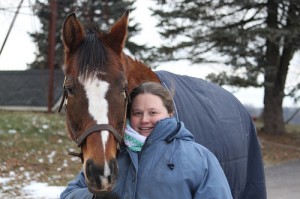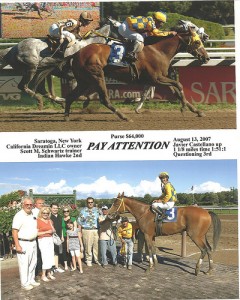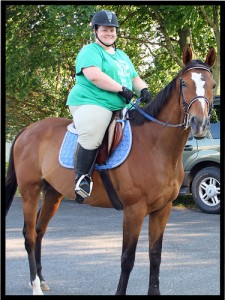Author’s note: This story was originally published in July 2010.
Amanda Smith started to pay attention to the plight of ill-fated racehorses shortly after Barbaro broke down at the 2006 Preakness Stakes. That’s when Pennsylvania pharmacist and pleasure rider started to ponder the ineffably sad ending that can come when their racing days are over.
Her curiosity led her to websites by exercise rider and anti-slaughter advocate Alex Brown, and soon she started following careers of horses who were once big earners before they dropped in class to run for relative peanuts in claiming races.
She started to monitor Alex Brown’s Top Bunk List, which follows careers of racehorses who have earned over $500,000 before they drop down to run in cheaper races. And as she scrolled through their photographs, she thought how how the “magnificent war horses,” as she calls them, were “owed a little dignity.”
Race Name: Pay Attention
Barn name: Payten
Sire: Take Me Out
Dam: That’s Ravishing
Foal date: March 14, 2001
Earnings: $510,734“This is when I decided to do something for one of these horses,” Smith says. “I figured that if a horse needed to be humanely euthanized, or adopted as a pasture pet, or could be turned into anything from a pleasure horse to a jumper, I would do that for them.”
It wasn’t long before her newfound attention to the matter led her to aptly named, Pay Attention, a seasoned campaigner who earned over $500,000 before earmarked to run at Penn National, the local track. She hastily made arrangements to meet him.
On March 12, 2009, Smith talked two colleagues into trading their white lab coats for something warmer, and joining her at the racetrack.
“I told them my goal was to retire a racehorse. So on this cold March night we went to see the great Pay Attention run his first race in about 11 months.”
He raced two more times after that. Then finally, on April 25, after coming in 10th in a 12-horse field, the decision was made to retire him, and Smith took him home July 1.This began months of learning to care for the aches and pains and specialized needs of a seasoned campaigner.
Initial veterinarian checks were promising.
His feet needed to grow out from the racing angles, and the decision was made to let him go barefoot for a while. Some mild back soreness was attributed to lost muscle fitness. And he needed dental work to address long incisors, lower molars and an overbite. But all in all, it was a good report.
Then, in the fall, things took a turn for the worse.
“Near the end of the summer we were noticing a general ‘failure to thrive’ about him,” she says, noting that he became grumpier, and developed ringworm and rain rot.
When it appeared he was experiencing abdominal discomfort, the veterinarian scoped him for ulcers. Although none were found, the vet couldn’t rule out lower GI ulcers, and he was put on an expensive medical regiment. Treatment included 28 doses of Gastro Gard, costing well over $1,000.
Although his good-natured personality returned, he remained underweight, and still suffered from patchy hair loss.
“By October/November he experienced the “crash” that can happen with ex-racehorses,” Smith says. “There are so many changes, in diet and in supplements and drugs, that the horse’s body reacts similarly to a human who changes their own medication regiment.
“It’s a huge change. Hormone levels and brain chemicals undergo tremendous fluctuations and it takes a long time for the system to adjust.”
But Smith stuck with her boy, who she calls Payten, and the payoff eventually came. He grew a bright, shiny coat, and previous sensitivities around the abdominal area vanished. “It was a complete turnaround,” she says.
And one day, after months of rehab, Smith took her OTTB to a field and climbed on. Their first ride was outside, bareback— it was amazing! That casual walk inspired her to get him ready for trail rides, and a more relaxed way of life.
It’s what she would wish for any hard-knocking racehorse who has earned so much at the track. And by helping this one, Smith feels she has added to the rising tide of people trying to do similar work across the country.
“Barbaro was the first horse I ever saw break down on the racetrack, and I never really knew that could happen,” Smith says. “The more I learned about the unfortunate endings some of them face, the more hell-bent I was on giving one of them the opportunity to avoid that demise.”
And so far, she’s helped one very dedicated racehorse move on to a happy and dignified retirement.





I read you blog faithfully, and each post leaves me smiling. It’s so heartwarming to know there are so many OTTB advocates out there watching out for these horses and finding homes for them. Good for Amanda and what a great job she did with him. I think that photo of her smiling aboard him says it all.
L. Melone, it makes me so happy to read a comment like yours, and know that my blog makes you smile. They’re good endings, mostly, because of people who work hard for the OTTBs.
Love reading the “oldies but goodies” and that picture with Amanda on Payten says it all. Happy horse, happy rider! Thanks for bringing this story back for us to enjoy again.
TB Dancer, thanks! This is from 2010 originally. I love hearing about the Top Bunk horses getting good lives.